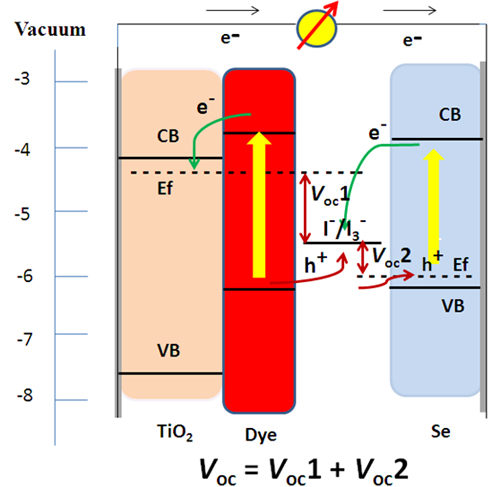New advances of dye-sensitized solar cell in Institute of Chemistry
Dye-sensitized solar cells (DSCs) have attracted increasing attention in scientific research and for practical applications owing to the potential advantages of low cost, easy production, flexibility relative to conventional crystalline silicon solar cells.
The research group led by Prof. SONG Yanlin, at Laboratory of New Materials, Institute of Chemistry, Chinese Academy of Sciences (ICCAS), made a series of new progresses on DSCs, and the relative results were published in Chem. Commun., Adv. Funct. Mater. and Angew. Chem. Int. Ed.. In DSCs, the dye is always a crucial element, exerting a significant influence on the power conversion and the device stability. With this in mind, they focused on the development of ruthenium bipyridyl dyes, organic dyes, and inorganic quantum-dots through modification of material structures and molecular design, and important advances were achieved with the results published in Inorg. Chimica. Acta. (2008, 361, 783-785), Chem. Commun. (2006, 2460-2462; 2009, 2201-2203; 2011, 47, 740–742; 2011, 47, 6461-6463)、Chem. Asian J.,(2010, 5, 1911-1917), Dyes and Pigments (2010, 87, 249-256). In addition, in order to eliminate the problems of leakage and corrosion of the common I-/I3- based liquid electrolyte remained in DSCs, poly(3-hexylthiophene) (P3HT) was employed to replace the liquid electrolyte, where P3HT functions as both hole transport media and auxiliary dye. The research was published in Adv. Funct. Mater.(2009, 19, 2481-2485). At the invitation of Prof. Gratzel’s group, they took part in the compilation on the book named as Dye Sensitized Solar Cells(EPFL Press, ISBN 9-781-4398-0866-5).

A solid-state dye-sensitized solar cell with P3HT hole transport material (Image by JIANG Kejian et al.)
For further improving light harvesting ability of DSC in different regions of the solar emission spectrum, a new tandem structure was proposed in DSC recently. The device comprises one active anode of dye-sensitized TiO2 film and one active cathode of selenium semiconductor, resulting in “internal tandem” in a single device with a high open-circuit voltage of 940 mV. The resulting DSC is different in structure from the common tandem DSC, and can be easily fabricated. The research paves way for future development of DSCs with high conversion efficiency.
The result was published in Angew. Chem. Int. Ed.(2012,51,10351-10354).

A tandem-structured solar cell with one active dye-sensitized anode and one active selenium cathode (Image by JIANG Kejian et al.)





